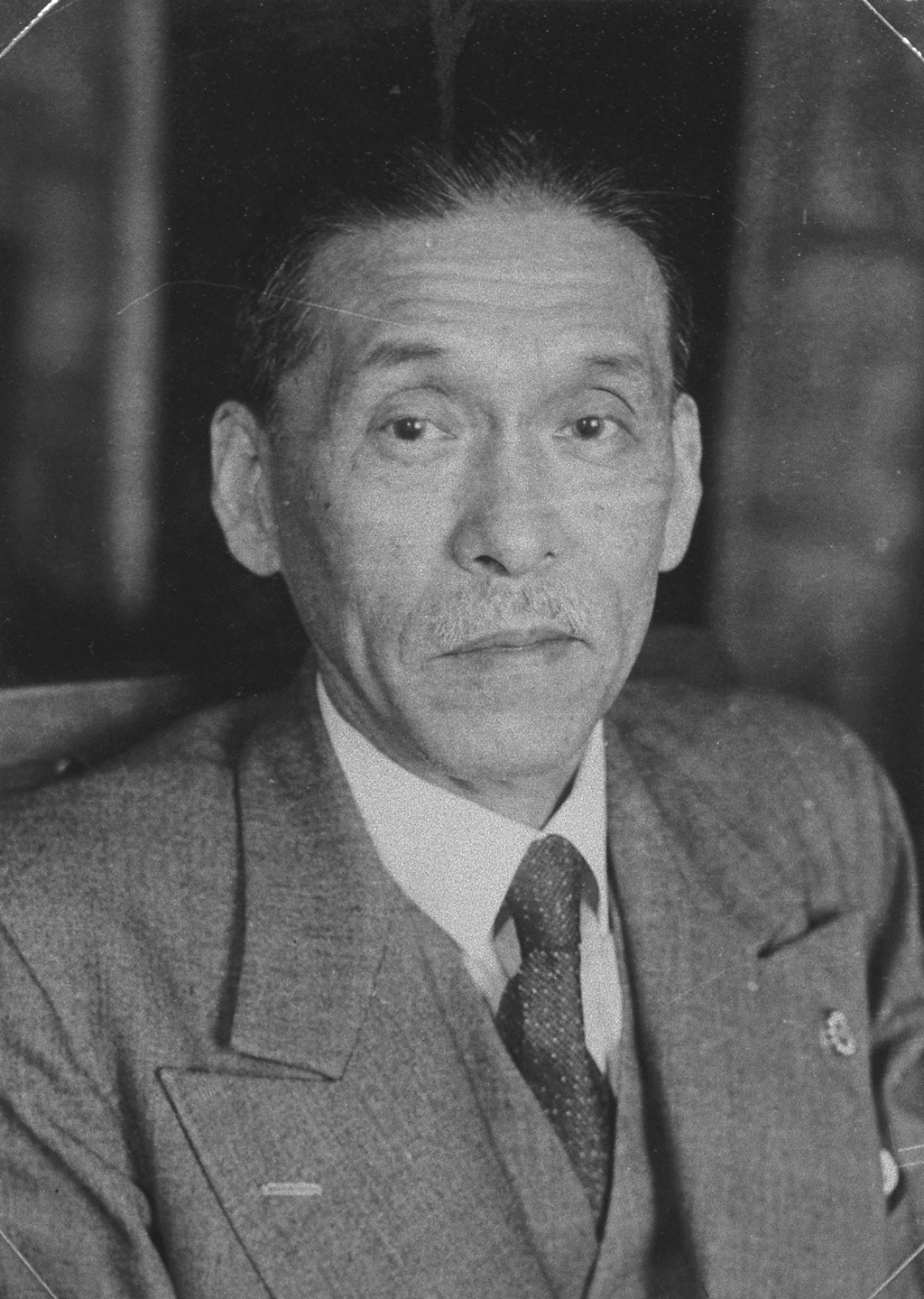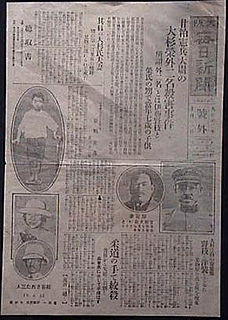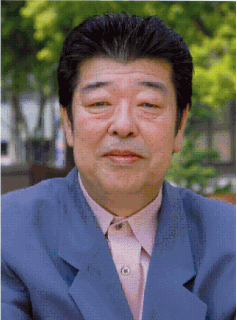
Hitoshi Ashida was a Japanese politician who served as the 34th Prime Minister of Japan from 10 March to 15 October 1948. He was a prominent figure in the immediate postwar political landscape, but was forced to resign his leadership responsibilities after a corruption scandal targeting two of his cabinet ministers.

The Ikedaya incident, also known as the Ikedaya affair, was an armed encounter between the shishi which included masterless samurai (rōnin) formally employed by the Chōshū and Tosa clans (han), and the Shinsengumi, the Bakufu's special police force in Kyoto on July 8, 1864 at the Ikedaya Inn in Kyoto, Japan.

The Amakasu Incident refers to a crime in which the Lieutenant Amakasu Masahiko was found responsible for the murders of two anarchists and a young boy in September 1923.

The October incident, also known as the Imperial Colors incident, was an abortive coup d'état attempt in Japan on 21 October 1931, launched by the Sakurakai secret society within the Imperial Japanese Army, aided by civilian ultranationalist groups.
The Military Academy incident, also known as the November incident was an attempted coup d'état that took place in Japan in November 1934. It was one of a sequence of similar conspiracies for a "Shōwa Restoration" led by radical elements with the Imperial Japanese Army.
The High Treason Incident, also known as the Kōtoku Incident, was a socialist-anarchist plot to assassinate the Japanese Emperor Meiji in 1910, leading to a mass arrest of leftists, and the execution of 12 alleged conspirators in 1911.

The Hibiya incendiary incident was a major citywide riot which erupted in Tokyo on 5 September 1905 in protest of the terms of the Treaty of Portsmouth, which ended the Russo-Japanese War of 1904-1905.

The Huanggutun Incident, or Zhang Zuolin Explosion Death Incident, was an assassination plotted and committed on June 4, 1928, by the Japanese Kwantung Army that targeted Fengtian warlord Zhang Zuolin. It took place at the Huanggutun Railway Station near Shenyang, where Zhang's personal train was destroyed by a railside explosion. This incident was concealed in Japan at the time and was referred only as "A Certain Important Incident in Manchuria".
The Toranomon incident was an assassination attempt on the Prince Regent Hirohito of Japan on 27 December 1923 by communist agitator Daisuke Nanba.
The Soviet–Japanese border conflicts was a series of battles and skirmishes between the forces of the Union of Soviet Socialist Republics and the Empire of Japan, as well as their respective client states of Mongolia and Manchukuo. Lasting from 1932 to 1939, most of the conflicts were small border skirmishes until May 1939, with the notable exception of the Battle of Lake Khasan. The border conflicts were resolved in a series of engagements at Khalkin-Gol, where the Soviets and Mongolians inflicted a decisive defeat on the Japanese. This resulted in the Soviet-Japanese Neutrality Pact. It should not be confused with the conflict in August 1945 when the Soviet Union declared war in support of the other Allies of World War II and launched the Manchurian Strategic Offensive Operation.

The Nikolayevsk incident was an international conflict in Nikolayevsk-on-Amur in the Russian Far East between Japan and DVR during the Japanese intervention. The culmination was the execution of imprisoned Japanese prisoners of war and survivors of Japanese residents without trial from 23 to 31 May 1920, which followed after the armed conflict between the guerrillas and the Japanese army from 12 to 15 March 1920 in Nikolaevsk-on-Amur. A total of 129 Japanese prisoners and a number of local residents and guerrillas were held in the prison at that time. The destruction of the town and the fortress and the execution took place after the evacuation of the entire population due to the offensive of the Japanese army. The Nikolayevsk incident was used by Japan as a pretext to justify the retroactive occupation of Northern Sakhalin, which was occupied by the Japanese on 22 April 1920.
Viscount Mishima Michitsune was a vassal of the Satsuma Domain during the Late Tokugawa shogunate, Home Ministry bureaucrat and viscount. He is also commonly known as Yahei or Yahée.
The Shishigatani incident of June 1177 was a failed uprising against the rule of Taira no Kiyomori in Japan. The conspiracy was discovered, and its perpetrators arrested and punished before any part of their plan was put into action.

The Incident is a 1978 Japanese film directed by Yoshitaro Nomura. Among many awards, it was chosen as the Best Film at the Japan Academy Prize ceremony.
The Red Flag Incident refers to a political rally that took place in Tokyo, Japan, on June 22, 1908.

The Hankou Incident was an incident that occurred on 3 April 1927 in which rioters and a few military units invaded the Japanese concession in Hankou, engaged in vandalism and looting, and attacked Japanese residents and consular staff. A number of servicemen of the Imperial Japanese Navy were injured, 150 homes were damaged and the total cost of the destruction was estimated at 920,000 yen. Dozens of Chinese civilians were also killed when Japanese marines fired machine guns at protestors. Some reports suggest that the incident occurred at the instigation of the Chinese Communist Party, however the riots were initially sparked by an altercation between Japanese marines and Chinese workers.

Katsuhiko Takahashi is a Japanese writer of mystery, horror, science fiction and historical fiction. He is a member of the Mystery Writers of Japan.

Japanese dissidence during the early Shōwa period in World War II covers individual Japanese opponents to the militarist Empire of Japan before and during WWII.
The Kobe Incident of February 4, 1868, also known in Japanese as the Bizen Incident, and in English as "Bizen Affray", later "the Bizen Affair", was spun into a scandal in Franco-Japanese relations which represented the first major international affairs challenge for the fledgling Meiji government of Japan, and the "extrajurisdictional international zone", or "Foreign Settlement" at Hiogo, at the time occupied by a community of foreign merchant-houses, with some naval presence of arms from the countries of their incorporation, including the US Marines, of whom more than fifty landed in the panic, a mere 21 days after the highest-ranking American, Rear Admiral Henry H. Bell, was killed.
The Popular Front Incident refers to the Imperial Japanese government's suppression of a perceived threat from the political left after the fall of Nanjing during the Shōwa period. During the incident, approximately 400 people were arrested by the authorities between December 1937 and February 1938. Amongst those arrested during the incident were Kanson Arahata, Hitoshi Yamakawa, and Ryokichi Minobe.













